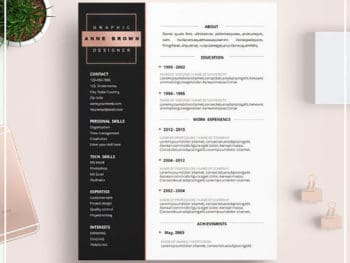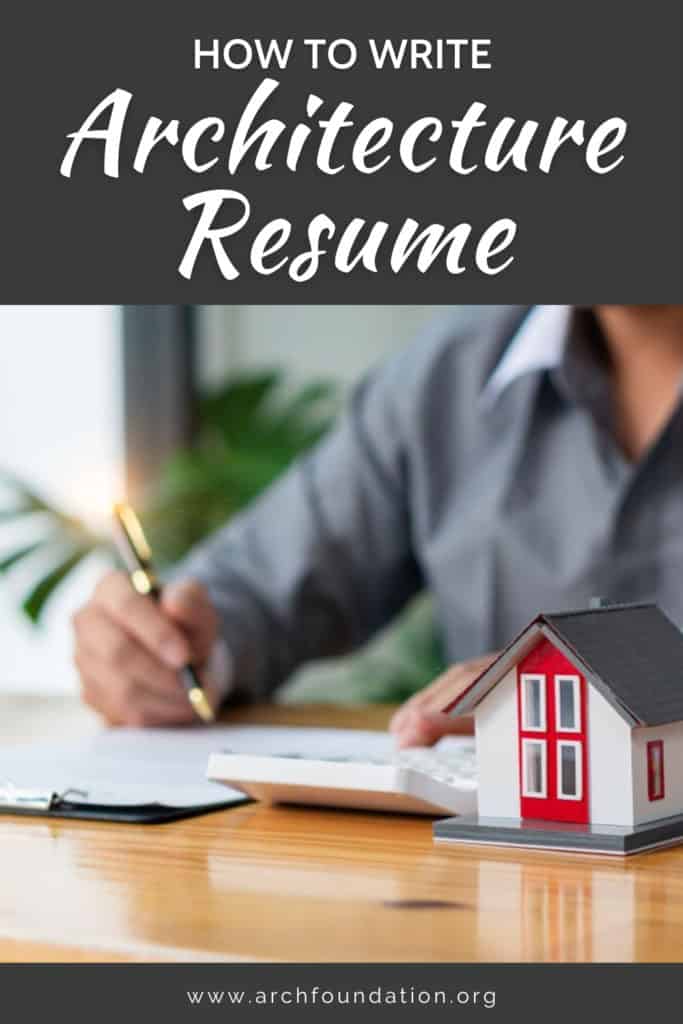How to Write Architecture Resume
A resume is your window to the labor market. Without a proper resume, you won’t even stand a chance to get the job, even if you have all the necessary skills and experience.
Maybe you have the technical knowledge to improve your resume, but you still can experience a dilemma about which things to highlight and what to avoid.
This guide will clear all understanding and lead you through the creation of a perfect resume that will ease the first step to your dream, architecture job.

Difference Between Student Resume and Senior Resume
Your resume when you are looking for an internship in architecture. or you have just graduated from an architecture school, differs from a perfect senior expert resume. Here is how.
Intern Resume or Graduates Architect Resume
As a freshly graduated architect, you would apply for entry-level positions such as urban planner assistant, junior architectural designer or else.
You probably don’t have much professional experience, and your potential employer doesn’t expect it, considering what the opening position is.
However, the resume and portfolio will differentiate you from other candidates. Create a resume that highlights your experience and always mention your GPA. Pay extra attention to the portfolio. Include pictures of your work, even if that was a part of a university course.
HR experts will look at the portfolio more because it will be more personal. It can showcase your skills and show your style.
On the other side, if your resume is short and professional, it is much more likely that you will raise interest as a candidate.
Never lie of exaggerate your experience of skills. If your resume leads to a face-to-face job interview, your interviewee will see through your lies and that will ruin any chance to get the job.
Watch more tips on how to make your resume, while still in architecture school. You can use it for internship applications:
Senior Architecture Resume
Updating your resume after many years can be challenging. There are many projects you wish to include, but you should be careful not to write a too long and boring list of things you have finished in the past.
Try not to exceed one page and to mention only information relevant to the given position. Sometimes, employers will look more at senior architecture resume than at the portfolio. That is because a portfolio of a senior can be a result of a company’s work, and not necessarily showcase your style and skills.
Therefore, analyze the job description for the open position and update your resume to match it.
Architecture Resume Sections
The resume consists of sections that are logically organized and equally important.
Before we move on to the sections, you can check this video for more tips on designing architecture resume, including colors, fonts, representing yourself in the perfect manner and more:
Header
Each resume starts with a header that tells your name, your title, your contact information, and the link for your online portfolio.
In the header, it is important to be specific. Don’t just write graduated architect, add the field of architecture you are most familiar with either by experience or courses.
The header section must contain the link for the online portfolio. If you forget to include it, sometimes the person who is reading your resume won’t even continue reading.
Also, double-check whether the link is dead, and update it.
Resume Summary
The resume summary is a brief description of everything about your education, experience, and interest. Keep the summary short and specific. Connect qualification and the projects and describe your vital skills.
Architecture Experience
The experience section should showcase the projects you worked on and give more information about the skills you learned. Don’t put every job you had in the past, list only the projects relevant for the position.
You should avoid generic descriptions and provide meaningful information. Include the software you used and specify your contribution to the project. Again, try to be concise and relevant to the job you want to get.
Skills Section
The skills section is highly valuable and a must-have section in every resume. There are soft and hard skills.
- Hard Skills
Hard skills are the technical and professional skills you have either learned at University or by working.
Break the sections into smaller parts and include skills for each field. For example, under Graphic design put Photoshop and Illustrator, under Drafting include AutoCAD, DraftSide, TurboCAD, etc.
The 3D modeling skills section should can consists of Sketchup, 3ds Max, Maya or else. The largest skill segment such as Civil Engineering can include Statics, Dynamics, Material strengths and science, heating, cooling, energy efficiency, etc.
Other skills you can include are drawing, sketches, clay modeling, 3D printing, sculpting, industrial design, interior design, etc.
- Soft Skills
Soft skills are social, communication and personal skills. Don’t underestimate the power of soft skills in your resume. Often, those can determine between two candidates with similar qualifications.
Again, shorter sections are the pattern you should follow. For example, if you have project management skills, make sure to specify them. Are you better at leading positions or budget planning, cost optimization, and time scales?
Include skills such as working under pressure, teamwork or individuality, proactivity, motivation, etc. Again, never exaggerate what you can do and what you can’t.
Education Section
The education section should be about your formal knowledge. Include graduation year, university and GPA. Make sure to specify the level and tittle your degree grants you.
Awards and Certificates
When it comes to awards, list only those related to architecture if you have any. The same applies to certificates. Some of the certifications that are useful for your career in architecture are the National Council of Architectural Registration Boards (NCARB), Leadership in Energy and Environmental Design (LEED –USGBC), American Institute of Architects (AIA), and National Architectural Accrediting Board (NAAB).
When listing a certificate you earned, make sure to write them correctly. Follow the next pattern for each certificate in your resume:
Name of certification – Affiliating Institution – Location – Date (month and year format)
Templates

Sometimes it is easier to find a resume template and fill it in with the chronological information. However, you should avoid it, because you can end up with a generic resume that won’t represent you properly.
Rather, first, think about things you want to include in your resume for the position such as skills and experience. Then search the templates for motivation and inspiration.
If you find anything that looks like it fits the list you have previously prepared, use it. Don’t forget to modify the slightest details, following everything we covered, to make sure the resume is unique.
Architecture is a competitive field, and you should do your best to make sure your resume highlights your good side and emphasizes useful skills and your positive sides.
Dos and Don’ts When Writing Your Architecture Resume
When creating a perfect resume, you can be creative, but still, you should follow some guidelines. If your resume is three pages long, it’s not creativity and uniqueness, it is a matter of unprofessionalism.
Similar to it, there are things you may and should include in a resume to get better results.
Follow this list of Dos and Don’ts in your architecture resume and end up with a winning resume for every job position in architecture.
Don’ts
I will start with the things you should avoid and how to transform an average resume to a perfect one. Here are tips on what to do and what to avoid when writing your architecture resume.
Don’t – Send Too Long Resume
You might think that if you put everything in your resume and explain your experience in detail, the chances for the job increase. Wrong.
An average employer spends no more than six seconds looking at the resumes of potential workers. That means that you have to include everything relevant to the job you are applying to concisely.
Resumes that are only one page long have the highest chances to catch the employer’s eye.
The purpose of the resume is to ensure a face-to-face interview. You can accomplish that by tackling the employer’s imagination. That way, you don’t have to list all projects you have ever worked on in the past. Instead, include the projects you are most proud of or that your contribution was the largest.
Don’t – Send the Same Resume for Every Job
First of all, the employer will notice the generic resume and is not the first impression you wish to leave.
Update your resume for each job you apply. Each job description in architecture is different. For example, you should highlight different skill sets if you are applying for an architecture job in private practice and the public sector.
If you are applying to a job within local authorities such as an urban planner, include the team management skills, public objects construction experience, and budget planning.
On the other hand, the 3D Exhibit designer job description can focus on creative solutions and versatility when working within various environments, brands, and clients. If that is the case, make sure that your resume emphasizes your ability to work on multiple projects at a time and the ability to come up with creative proposals.
Don’t – Talk Too Much About Formal Education
An architect’s resume should include your skills, education, experience, awards, and aspirations.
Of course, you should list the courses and University, but don’t make your resume about it. If you have just finished your studies, and you don’t have many practical experiences behind you, rather focus on skills and internships. Describe the projects you were working on while you were on an internship program.
Also, avoid talking too much about jobs that are not related to the architecture field. For example, if you have spent the last summer as a waiter, it isn’t something that contributes too much to your professional experience.
Opposite, if you worked on some civil projects, maybe even as a volunteer, your employer might be interested in the things you learned.
Don’t Make Mistakes and Send Outdated Resume
Typos and grammatical errors can leave a negative impression on your potential employer. Always proofread your resume to make sure there are spelling or grammatical errors.
Never send the outdated resume. After your contracts expire, always update the resume with the new skills you’ve learned working on the previous job. For example, if you were hired in the initial phase of some construction project, make sure to include that in your resume. That way, your potential employer can see that worked on opening phases of the project, participated in planning, resource distribution, or else.
Dos
Now, let’s continue with the tips on what to include in your resume.
Do – Use Graphic

Architect work is visual and includes a deep understanding of space and objects. Therefore, for an architect graphic can play a vital role and make your resume stand out.
To incorporate graphics properly in your resume, make sure it is informative and easy to understand. Don’t showcase all your designing skills by creating a work-of-art resume that your employer won’t understand. The graphic should either visually present the information you already included in the resume, or be the information.
The wise use of colors to highlight the most important skills relevant to the job could do the trick. Clean and sleek resume design can leave the impression that you are pedant, punctual, that your work is elegant.
You wont to avoid looking all-over-the-place and unfocused.
Watch the video to learn how to create a resume in Photoshop that can ensure a job interview. Simplicity is the key, but this video can help you to utilize basic tools:
Do – Include Industry Terms
Even though your resume sometimes has the first contact with someone outside the architecture field, such as Talent hunters’ agency or HR expert, you can include architecture terms.
To do that, you must be 100% sure that you understand it. For example, there is a major difference between blueprints and sketches.
Be specific in your description. If your latest project included designs of specific joint works such as mortise and tenon, say it like that.
Specify whether your experience included mixed-use projects. Versatility in your working experience can provide you leverage against your competition.
What Skills Do You Need to Be an Architect?
An architect should have designing skills, knowledge about materials and construction and specific architecture software skills.
Additionally, an architect should have excellent verbal and written communication, analytical and problem-solving mindset.
What Is a CV vs Resume?
The primary difference between CV and a resume is the amount of information they cover and length. A resume is usually one page long and only shows the most important skills, experience and highlights education and certificates. CV is longer and describes everything about your professional career – all projects, all skills, both formal and informal education.
This video from Evolving architect will cover a majority of the important factors for architecture resumes such as work experience, proper structure and things to delete from your resume draft:
Bottom Line
The first step in writing an architecture resume is always an analysis of the job description. Your resume should represent how you can contribute to the chosen position and how you can help the employer achieve goals.
Before you start searching for a template, think about things you want to include.
Be careful with each resume section – heading, skills, experience, and summary. Each section should represent you in the most flattering, but truthful way.
There are few things to have in mind when making your resume. The resume should be concise, relevant, truthful, updated and unique. Its purpose is to ensure a job interview and not to be a complete autobiography.
Keep this guide in mind and proofread it several times to avoid typos and grammar mistakes.
What do you think are the three most important things that every resume must include? If you have experience in getting architecture jobs, share your tips on how did you structure your first resume. It will be useful for freshly graduated architects.
Share your thoughts, you can inspire us!





